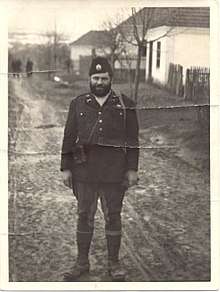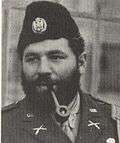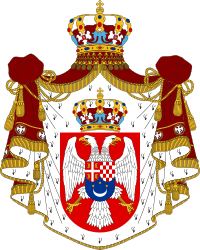George Musulin
George "Guv" S. Musulin (April 9, 1914 – February 1987) was an officer of the Office of Strategic Services (OSS) and naval intelligence services, and in 1950 became a CIA officer.[1]



Early life
George Musulin was born into a Serbian family in New York City and grew up in Johnstown, Pennsylvania. He graduated from the University of Pittsburgh, where he played with the university's football team during their national championship year of 1937.[2] After college he played professional American football in Pittsburgh, St. Louis and Chicago.[3]
Second World War
Musulin became a captain in the OSS during the Second World War.[4] In mid-October 1943, Musulin, as part of a U.S. military mission, parachuted into Yugoslavia to the headquarters of General Draža Mihailović. In January 1944 Musulin was a delegate on the Ba Congress organized by Draža Mihailović.[5]
On 29 May 1944, Musulin, aided by Chetniks, was evacuated along with the British and American mission and 40 rescued Allied airmen to Bari, leaving General Mihailović without support. In Bari Musulin proposed another rescue of American airmen shot down over Yugoslavia. He again parachuted into Chetnik territory, near the village of Pranjani, where there were several hundred American airmen rescued by Chetnik forces and hidden from the Germans. Musulin successfully commanded the airlift Operation Halyard, the rescue from the air of about 447 U.S. airmen from Nazi-occupied Yugoslavia, from 10 to 29 August 1944. Although this operation was successful due to cooperation from General Mihailović, Musulin had been ordered not to give the Chetniks political promises, an order he violated when he allowed members of General Mihailović's political mission to board the plane. At this time the British were the main Allied authority in the Mediterranean, and their Special Operations Executive (SOE) complained to Musulin's superiors in the OSS, who decided to expel him from the service. In late 1944 Musulin was transferred to the Far East as part of the naval intelligence service, where he stayed until the end of the war.
Post war years
After the war the CIA conducted its own investigation into Musulin, which concluded that he had acted appropriately and that he had been the victim of James Klugmann and other British agents in the SOE with communist sympathies. For his efforts, Musulin was awarded the Legion of Merit.
Musulin enlisted in the Office of Naval Intelligence and joined the Central Intelligence Agency in 1950, where he remained until he retired in 1974. Musulin continued to serve as a field operations officer. He was part of a team that was responsible for recruiting and training Cuban exiles to fight against the regime of Fidel Castro. He was disappointed with the failure of the Bay of Pigs Invasion and the loss of human life.
Musulin died of complications of diabetes at the age of 72.
See also
References
- "G.S. Musulin, Who Got G.I.'s Out of Yugoslavia, Dies at 72". 26 February 1987.
- "UNIVERSITY OF PITTSBURGH 1937 FOOTBALL TEAM PHOTO".
- Services, From Times Wire (28 February 1987). "George Musulin; Led Airlift That Rescued Fliers in World War II". Los Angeles Times. Retrieved April 27, 2016.
- "93-year-old's WWII feats are hidden no longer". Pittsburgh Post-Gazette. Retrieved April 27, 2016.
- (Vesović & Nikolić 1996, p. 57):"Конгресу је присуствовао и Џорџ Мусулин, делегат амери- чке војске и председника Рузвелта."
Sources
- Vesović, Milan; Nikolić, Kosta (1996). Ujedinjene srpske zemlje: ravnogorski nacionalni program. Vreme Knjige.CS1 maint: ref=harv (link)
External links
| Wikimedia Commons has media related to George Musulin. |
- THE O.S.S. SOCIETY, INC, Spring 2005.
- The O.S.S. Society, Newsletter, Summer/Fall 2007.
- gregoryafreeman.com
- O'Donnell, Patrick K. (28 October 2014). Operatives, Spies, and Saboteurs: The Unknown Story of the Men and Women of World War II's OSS. Simon and Schuster. pp. 85–87. ISBN 9780743235747.